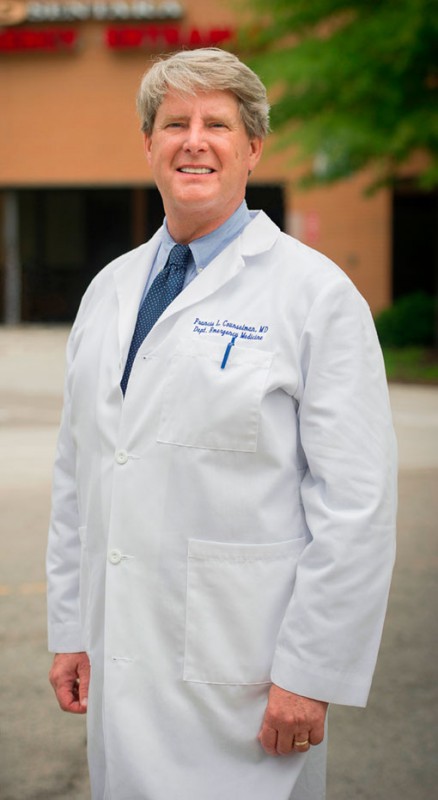 Emergency Physicians of Tidewater
Emergency Physicians of Tidewater
Chair, Department of Emergency Medicine, EVMS
It’s not every physician who’s treated stingray envenomation or needlefish punctures. For Dr. Frank Counselman, it’s just another day in the Emergency Department. “Living on the Bay, so close to the Atlantic Ocean, these are frequent if not regular occurrences,” he notes. “And they make fun anecdotes to include in my lectures. People are fascinated, whether they live near the water or as far away as Kansas.”
Frank Counselman always knew he wanted to be a doctor, but didn’t go to medical school right out of college (Notre Dame, ’79, cum laude.) Instead, he took a year and taught high school science, and discovered a love for teaching that has stayed with him throughout his career. “It was at the same high school I attended, St. John’s College High in Washington, DC,” he says. “I was very fortunate that a formal certificate wasn’t required to teach there. I had no idea I’d like it as much as I did.”
After a year at St. John’s, he applied to Eastern Virginia Medical School, where his high school teaching experience stood him in good stead. “As a fourth year, you teach third year students,” he says, “It wasn’t formal, but it was clinical teaching, and I really enjoyed it.”
Dr. Counselman didn’t enter medical school with the idea of becoming an emergency medicine physician. In fact, during his last year at EVMS, he hadn’t yet decided on a specialty – but he got some good advice from a Chief Resident in Internal Medicine. “He told me to do a year of internal medicine,” Dr. Counselman remembers, “because no matter what I finally chose, it would be a good foundation.”
Fortuitously, his first rotation in internal medicine was in the ER – a new experience for him, as he’d never had an emergency medicine rotation in medical school. “That wasn’t uncommon in the early 1980s,” he explains. “I was immediately excited about being able to treat so many different cases in a day, using so much of my training. We’d treat a heart attack patient, a teenager with appendicitis, a worker with an industrial injury – at the end of the day, you really felt like a doctor!” Realizing how much he enjoyed the work, he entered the emergency medicine residency program at EVMS.
Part of what he liked – and still likes – about emergency medicine is the diversity of people he sees. “When most medical students pick a specialty, they lose a certain part of the patient population,” he says, “but that doesn’t happen in my field. If you go into pediatrics, you won’t treat adults. If you go into OB/GYN, you don’t treat men. In emergency medicine, we see everybody – at all stages of life, all throughout our careers. That’s tremendously appealing.”
It’s also procedure-oriented, which he finds very satisfying. A patient might present with a bad laceration that’s bleeding, painful and looking horrible, Dr. Counselman says, “We can take care of a severe injury like that on the spot, clean it out, sew it up and it immediately looks and feels better. And the patient is very grateful.”
Of course, few cases involve injuries from sea creatures – many emergency room visits are occasioned by routine complaints like chest pain, abdominal pain, sprains or headache. These presentations can range from the simplest etiology to life-threatening illness; thus the emergency medicine physician is required to be a diagnostician first and foremost. “In the ER, we’re responsible for everybody who comes through the door,” Dr. Counselman explains. “We’re required to have a broad knowledge base; we’re seeing patients with urologic, ophthalmologic and neurological problems as often as those with cat scratches or kids with fever.”
Dr. Counselman and his team take care of all patients initially, but when their cases meet trauma alert criteria, they support the trauma surgeons by managing the airway of these patients so the trauma team can do its work.
Because no one is turned away from the emergency department, regardless of their insurance status or ability to pay, he notes, “We’re referred to as the ‘safety net’ of health care. Patients used to see their primary care physician with complaints, but with the growing shortage of PCPs, the mindset is more and more ‘go to the emergency room.’ And as more people come into the health care system, that demand will only continue and increase.”
Dr. Counselman maintains his love of teaching. He spends about 50 percent of his time working in the emergency department seeing patients, but as he says, “That’s also teaching.” He considers himself fortunate to have affiliated with Emergency Physicians of Tidewater. “They recognized from Day One the importance of residency education in emergency medicine,” he says. “EPT, in conjunction with EVMS, founded the residency here: the first in Virginia and one of the oldest in the country. EPT provides me the protected time to teach and do administrative work as Chair of the Department.”
Dr. Counselman contributes to several emergency medicine journals, and lectures around the country. His greatest fortune, he says, is his wife Liz. “She’s incredibly supportive. Any success I have is totally shared with her. Any failure is mine alone.”
About his exhausting schedule, he says, “Someone told me once that if you find something you love, you’ll never work a day in your life. It’s corny, but it’s true.”<

